As we pass the 10th anniversary of the 2011 Tohoku earthquake and tsunami, reflect with a story about what happens when communities receive the resources they need to recover.
The nightmare began after a 9.0 magnitude earthquake ripped through the Pacific Ocean off Japan’s northern coast. That was on March 11, 2011, and it was the first of three back-to-back catastrophes for Japanese communities.
The earthquake—record-breaking for Japan and one of the five most powerful earthquakes ever recorded globally—triggered 647 aftershocks. Some of the aftershocks could be felt around the world, and many came with tsunami warnings. Only 15 minutes after the quake hit, the first tsunami wave crashed into Japan’s coast. The waves—some as high as a 12-story building—engulfed entire towns and flooded more than 500 kilometers of coastal land.
“Our life changed drastically due to the tsunami at the time of the Great East Japan Earthquake on March 11, 2011,” Suzuki Eiji wrote in 2015.
Suzuki lived in a coastal village named Kitakama in Natori City, Miyagi Prefecture. About 400 people, mostly farmers, lived in 100 residential houses. Fifty-five residents lost their lives in the tsunami, and farms were destroyed.
“We lost our living…just in one day,” Suzuki said.
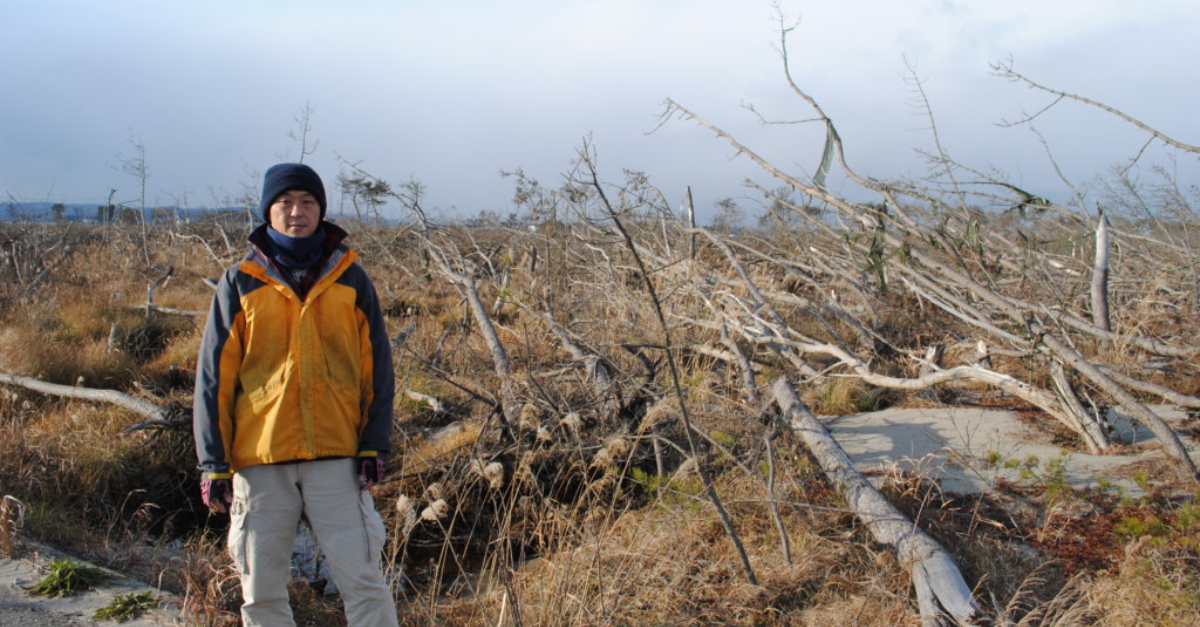
The damaged Natori coastal forest. Photo: OISCA International
The tsunami alone claimed more than 15,800 lives. And on top of this catastrophe, the giant waves also overwhelmed the Fukushima nuclear power plant, sending radiation through the countryside and the ocean. More than 470,000 people fled their homes, not knowing if they would ever return. Many did not.
It’s now been 10 years since the earthquake and tsunami in Japan’s Tohoku region, but for many, that devastating day continues to take a toll on their minds, hearts, and sense of security.
Before the disasters on March 11, Mr. Hitoshi lived a comfortable life growing vegetables in his garden near the coast in Natori City. But he lost both his home and his source of income that day.
Mr. Hitoshi was determined to rebuild his livelihood, but he struggled to grow high-quality crops on his salt-saturated farm. The salt was from the tsunami’s initial waves and the sandy winds that now blew from the coast to the farms with ease. A coastal forest of Japanese black pine trees once protected the towns, but after the tsunami uprooted the trees, there was nothing to defend the farms against the sea’s daily attacks.
Mr. Mori, a community member living in Natori City more than 2 kilometers from the coast, said the coastal forest was an important part of the landscape:
“We did not realize how the pine trees on the coast have guarded our lives from the sea—from its wind, tide, and sand—until they were gone.” —Mr. Mori

Aerial images show the coastal degradation the tsunami caused. Photo: OISCA International
Salt significantly decreases the agricultural production of most crops, affects the soil’s physicochemical properties, and disrupts an area’s entire ecological balance. Given that more than 80% of Natori City residents engaged in agriculture, the salty ground was a disaster in itself.
The loss of the trees also resulted in a more fundamental challenge: fear. Without trees separating the towns from the coast, the ocean—and all the pain it caused—felt closer than ever.
Mr. Mori told staff at OISCA International—a Japan-based nonprofit that focuses on environmentally and culturally sustainable development—about this fear. “Because of the former coastal forest, the sea seemed far away. Mr. Mori did not expect the tsunami would come to his house 2 kilometers away. Without the vegetation, Mr. Mori was constantly in fear that big waves would come and cause even more destruction,” Project Coordinator Ma. Grazen Acerit wrote.
The team at OISCA International knew they needed to do something to help people like Mr. Mori and Mr. Hitoshi.
Just seven days after the 2011 Tohoku earthquake and tsunami, OISCA International established a local project with a big goal: restore 100 hectares of coastal forest in Natori City.
And they wanted to ground their work in community needs. OISCA International focused on restoring livelihoods. They paid Mr. Hitoshi and other farmers to help plant local vegetation, providing urgently needed economic relief.
“Mr. Hitoshi and the rest of the tsunami survivors felt the need to restore the coastal forests for the immediate recovery of their community. Although still suffering, Mr. Hitoshi and other survivors are working in collaboration with OISCA, the local and national government of Japan, forest experts, and funding agencies,” Ma. Grazen said in a 2014 report.
OISCA International has employed more than 8,448 tsunami survivors like Mr. Hitoshi to plant more than 370,000 Japanese black pine trees since 2011.
And for the local team at OISCA International, Mr. Hitoshi, Mr. Mori, and their neighbors are not beneficiaries or victims—they are the heart and operations of the restoration.
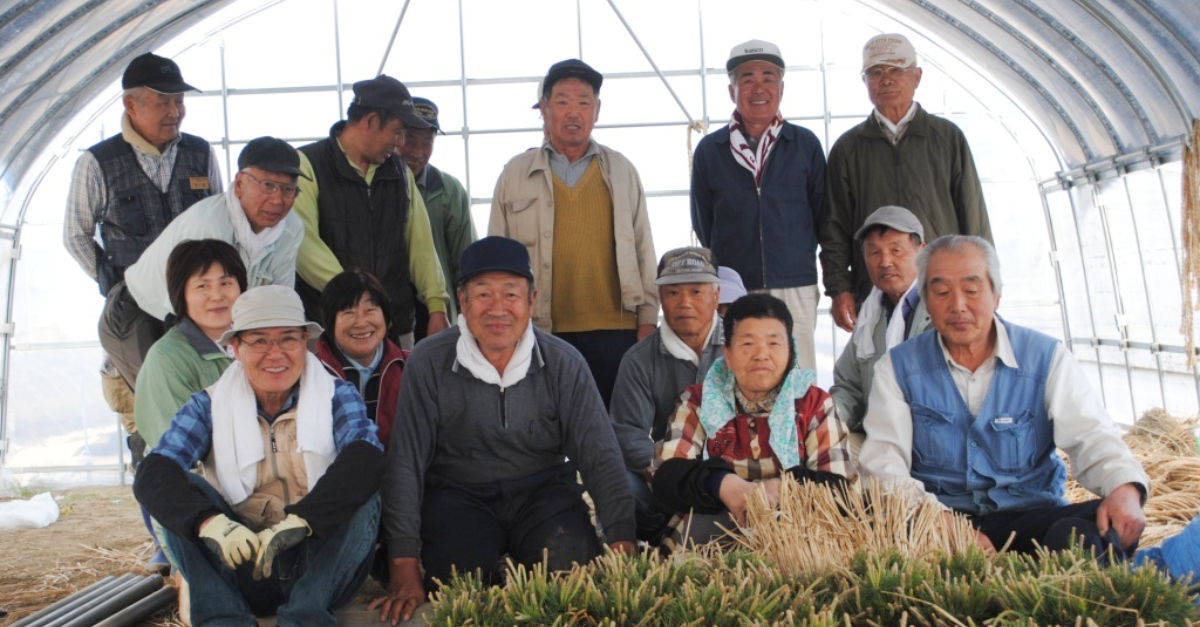
Mr. Mori and other Tohoku earthquake and tsunami survivors in the greenhouse. Photo: OISCA International
“This approach encourages a sense of ownership and guarantees a sustainable, long-term involvement of the tsunami survivors like Mr. Hitoshi. They are actively involved in the decision-making and actual project implementation,” Ma. Grazen said.
For Mr. Mori, the project was an opportunity to reconnect with his lifelong friends and neighbors after a year of isolation. Mr. Mori and many of his neighbors weren’t able to return to Natori City to rebuild their homes because of safety concerns. The survivors were relocated to different areas, often away from their friends and relatives.
Mr. Mori, who also lost his wife in the tsunami, returned to the village one year later. He was unsure of what the future would hold. That’s when he was asked to join the coastal restoration project.
“I feel grateful for the project since it is helping me find a new purpose in life. Since I am working with the people whom I have known since I was a kid, communication is not difficult, and work here is a lot of fun,” Mr. Mori told Moeko Shinohara, a GlobalGiving Field Coordinator, in 2014.
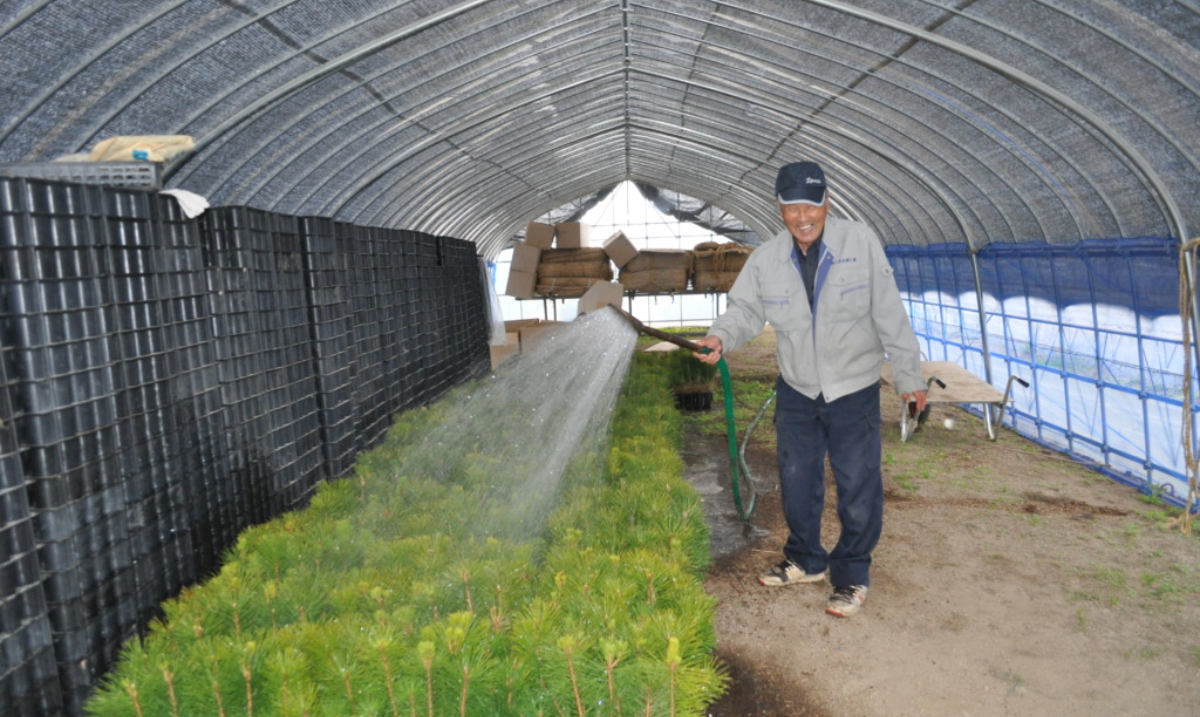
Mr. Mori waters seedlings before transplanting them. Photo: OISCA International
A truly global aid response fueled OISCA’s work. People from all over the world gave to GlobalGiving’s Japan Earthquake and Tsunami Relief Fund, which sent unrestricted funds to the project in Natori City. OISCA International raised an additional $14,000 through its GlobalGiving project to restore the coastal forest.
Even with the support of global donations, restoring an entire forest was no easy task. So, the nonprofit mobilized more than 11,000 volunteers to help their local team accomplish this massive undertaking. Many of the volunteers returned to the region year after year, including Izumi Kazuko, who drove 10 hours from Osaka City to help monitor the planted seedlings.
But it was the local survivors like Ms. Shukuko who cared for the seedlings like children. Ms. Shukuko was in charge of weeding and watering the seedlings at the nursery, according to local Project Coordinator Kazuyo Suzuki. Ms. Shukuko would notice immediately when something was wrong, like the sudden wilting of seedlings, for example. Kazuyo said that, among other factors, was part of the success of their seedling production.
“It may not be scientific, but we believe the love of the more than 10,000 people who get involved with the project helped in the steady growth of the black pines.” —Kazuyo
The volunteers and community members developed a sense of camaraderie and belonging as they worked together, Kazuyo said. That stood in direct contrast to the isolation they felt after being relocated in the tsunami’s aftermath.
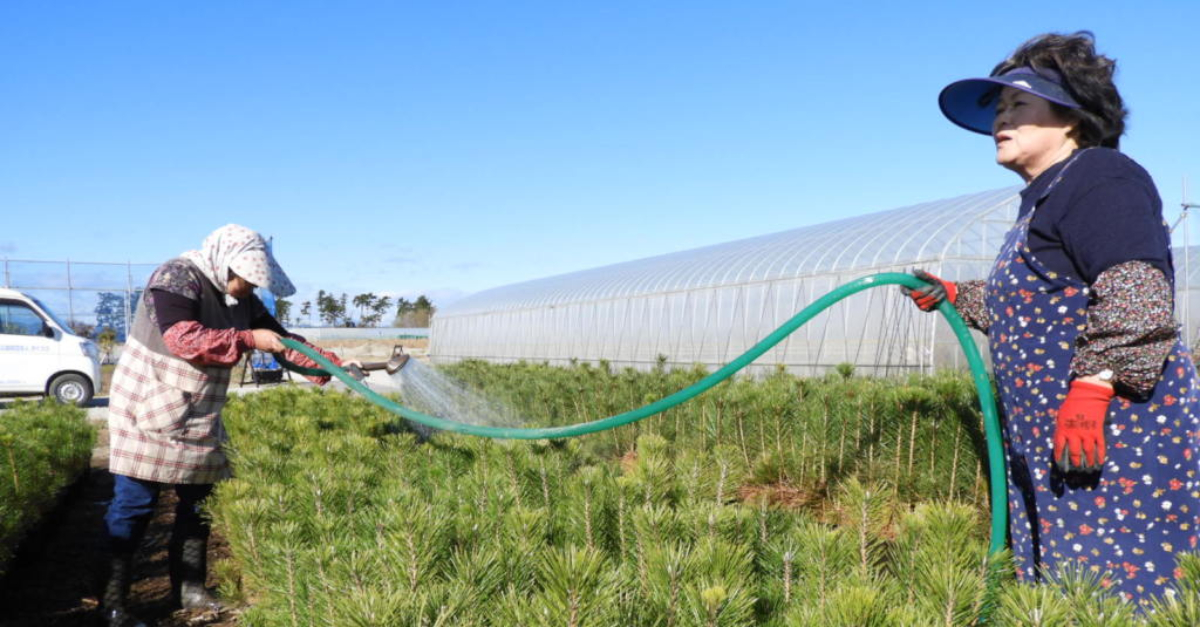
Ms. Shukuko watering the seedlings. Photo: OISCA International
For seven consecutive years, OISCA had a 99% survival rate for the Japanese pine trees. Their secret? Grow the seedlings at a nursery for two years before transplanting. That gave the young trees enough time to develop in a controlled, salt-free space. They also saw great results by using polymers to support regeneration.
Japan ranks highest on the Global Climate Risk Index, and as the warming climate leads to more frequent disasters like the Tohoku earthquake and tsunami, projects like OISCA International’s coastal forest restoration are vital and deeply beneficial. OISCA International estimated their site will likely absorb more than 900 tons of carbon dioxide emissions within 15 years. That is equivalent to removing 198 passenger vehicles from the road for an entire year.

Aerial shot of the coastal forest after ten years of restoration. Photo: OISCA International
With tiny seedlings and 10 years of care, OISCA International’s local team turned a huge pile of dead branches and debris left by disasters into a lush forest.
Mr. Mori, Mr. Hitoshi, and Ms. Shukuko happened to be impacted by a series of tragic events. But they’re now protecting future generations from the same tragedy through forest restoration.
The OISCA Director in Charge, Toshimichi Yoshida, expects to keep the project going until at least 2040. “We will continue until the 370,000 black pine trees become a resilient forest that will protect the lives of the Natori citizens from tsunamis and storm surges,” Toshimichi said.
“It’s said that tree planting is not the end of reforestation, but rather it is the start.”
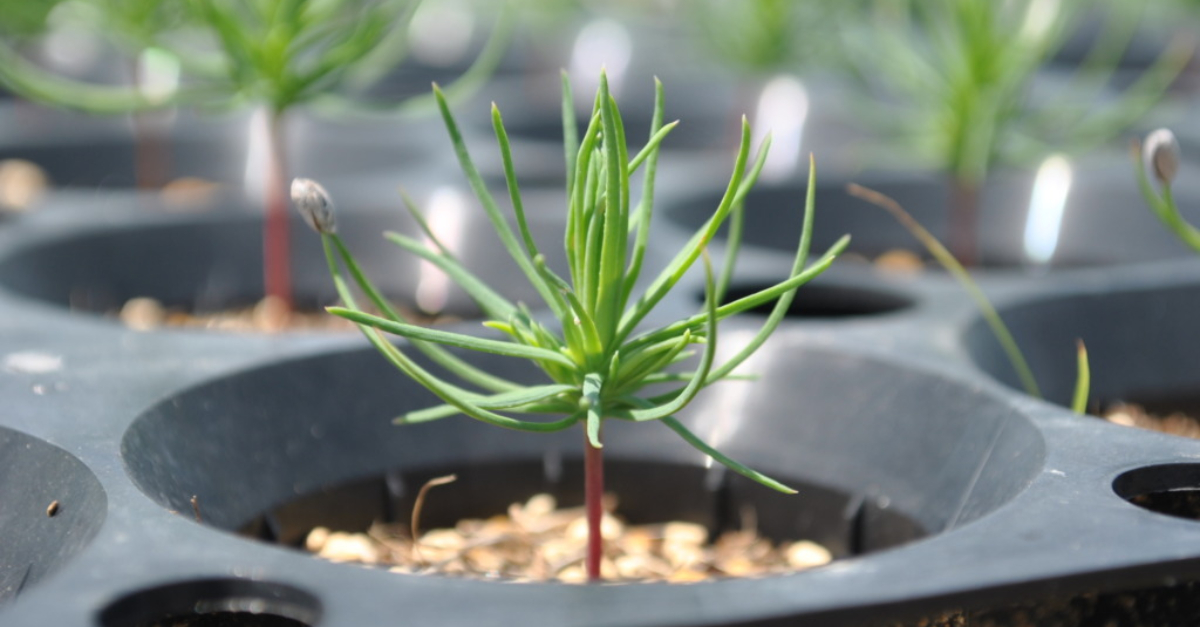
A black pine seedling in 2018 that was planted in 2016. Photo: OISCA International
Support OISCA International’s work to protect people in Natori City and restore the coastal forest after the 2011 Tohoku earthquake and tsunami. Donations up to $50 will be matched at 50% from March 8-12, 2021.*
Featured Photo: Restore 100 Hectares of the Miyagi Coastal ForestFind exactly what you're looking for in our Learn Library by searching for specific words or phrases related to the content you need.